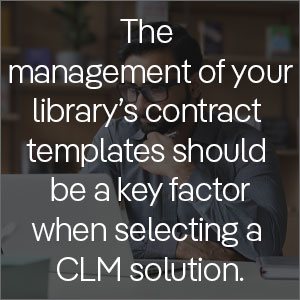It’s 2021. You have taken a long, hard look at the fiercely competitive legal technology market landscape. You have properly assessed various contract lifecycle management (CLM) solutions and providers. Now, you are faced with the most critical question in your journey: which type of solution will best meet your company’s requirements — not to mention your own goals and outcomes?
Naturally, the first thing to do is to look closely at your current situation. What are the gaps in your current contracting processes — those that are preventing contract efficiencies from end to end? Where are you in your legal digital transformation, when it comes to contract management?
Recently, we published a white paper about how to properly view the market landscape, evaluate solutions, and define your contract management system (CMS) needs. Written by my colleague Richa Kaul, ContractPodAi’s Chief Strategy Officer, it provides recommendations and tactical frameworks for general counsel (GCs) and legal departments that are interested in acquiring a CMS.
In a previous blog post, we listed five key categories — based upon Richa’s white paper— that should be top of mind during your CLM evaluation process. Beyond those five categories, we have also identified eight critical factors that you should consider when defining your own CLM needs. Depending on your requirements, these factors can help determine what type of solution will suit you best.
1. Contract Generation
Regardless of your role — GC, staff attorney, contract manager, paralegal, sales operations leader, or another contract author — you may find yourself struggling to create, edit, and publish quality agreements and related documents at times.
However, contracts best represent and protect your company’s interests. In fact, I like to explain that every contract is the “code” for human — and business — relationships. Your ability to leverage terms, clauses, and other content from previously successful agreements have a direct bearing on new business opportunities. The management of your library of contract templates, then, should be a key factor in your selection of a robust CLM solution. Ideally, that solution will have an AI-powered self-service contract desk, which can select — and suggest — suitable language to apply to the business scenario in front of you.
2. Contract Digitization
Many lawyers and legal professionals are still working with a mix of paper, scanned contracts, and those that were born digitally. Unlocking the insights and critical data contained within scanned (or — even more terrifying — paper contracts stored in those basement filing cabinets) may be difficult. Once you have made a shortlist of reliable vendors, then, it is important to ensure the vendor solution you are investigating can improve your level of digitization.
Of course, there are many business attributes and factors that relate to your industry that determine your level of digitization also. For instance, legal and regulatory standards for records management have a lot to do with the way you store and manage contracts, as well as the way you digitize contracts going forward. Further, things like electronic signatures, access permissions, version control — and the organization of your smart contract repository — all depend on your current digital state.
3. Contract Discoverability and Searchability
For mid-to-large-sized businesses with large contract repositories, finding individual agreements — along with the clauses and terms within them — is essential to maintaining business productivity and momentum.
Advanced OCR, ICR, and indexing functionality are quite valuable for this reason. AI-enhanced cognitive search capability — with enhancements like proximity, wildcard, and fuzzy search options — helps you find pre-vetted terms quickly, accelerate contract authoring, and increase the likelihood of customers accepting terms that have satisfied other customers, suppliers, or partners in the past.
4. Collaboration and Redlining
During negotiations, as contract versions are sent back and forth between the parties, numerous comments, redlines, and changes can be confusing and even counter-productive. Using the native redlining function in Word, buyers or sellers can mishandle contract versions as negotiations drag out —or worse, a party can forget to turn on “Track Changes” and send back a copy with no markup! Errors in manual file versioning can happen during high-pressure bargaining, too.
Fortunately, a CLM system — with a secure collaboration space — allows you to invite your negotiation partner to review the contract terms in real-time. Not only can you speed up contract review cycles, but you can also discuss terms openly and minimize any misunderstanding and frustration resulting from versioning errors or misunderstood clauses.
5. Workflow and Approvals
As legal professionals, we like to think that every document requires a thorough, detailed review. In many cases, the level of review also depends on the value of the deal, the nature of the transaction, the industry your business competes in, internal contracting requirements, and various policy and regulatory compliance obligations.
A CLM system equipped with a properly trained AI-powered contract review and compliance features goes a long way in easing the burden of post-authoring reviews. Where template-based agreements with pre-vetted standard terms are concerned, automating approvals of buy-side or sell-side contracts streamlines business transactions. What is more, establishing parameters for what can be auto-approved — around price discounts, payment terms, or other variables — helps executives stay focused on high-value opportunities and delegate less strategic transaction approvals to bots. Contracts can then be routed to executives or operational staff if the system identifies any anomalies or non-standard terms.
6. Analytics, Reporting, and Obligation Tracking
Do you have real-time visibility into contracts that are up for renewal soon? Can you get a snapshot of KPIs like total contract value (TCV) and annual contract value (ACV), percentage of service engagement milestones met, or order value variance from original contract value (OVV)?
A CLM platform, with a built-in, cognitive reporting engine, helps you to quantify these metrics and others, and understand your financial responsibilities. It also offers real-time integration with dashboard systems, if you standardize your reporting on applications like Microsoft PowerBI or similar services.
Equipping more line-of-business managers with analytics tools, which do not require technical skills, enables you and your team to make data-driven decisions. By being proactive about your analytics, you can seek out and identify any contract terms that you are in danger of missing. By rectifying those situations, you can then generate significant personal and financial ROI from your CLM system.
7. Business Scale Relative to CLM Solution Needs
Over-investing in your contract management suite may be nearly as painful as investing in a system that is missing key features. But by being realistic about your business size, annual revenue, geographic market coverage, growth trajectory, and contract processing volume, you can better choose a solution vendor and tier.
In today’s SaaS-based world, many CLM systems are available. Asking yourself what functionality your company needs helps determine the solution you’ll require: do you need insightful analytics or only the number of documents? Will you be integrating with Salesforce, Workday, SAP, or other third-party CRM/ERP systems? How many users will be working with your CLM system, and are the only legal users or enterprise-wide? Generally, my best experiences have come from vendors that understand the importance of growth and flexibility. In the CLM space, this means starting off with an operational CLM platform that allows you to add deep analytics, advanced workflows, and other strategic functions as your business grows and evolves.
8. Documentation of Your CLM Solution Needs
Depending on your company’s procurement process, and your industry and business size, you may need to issue an RFP to a shortlist of vendors. For some guidance on writing your CLM RFP, we offer our guide template here. You can also assess your CLM readiness online by completing our Contract Management Readiness Scorecard.
Perhaps above all else, though, the ease of doing business with vendors should be considered when defining your CLM needs. Vendors should help you develop your business case and select solutions that are the best fit for your legal department and company (and a great vendor will even tell you when its solution may not be the right fit!) Better yet, vendors should support you on your digital transformation journey and ensure your success in the long run.
In the next blog post in this series, we will summarize many of the key points in this blog post and discuss how to start your legal tech deployment. In the meantime, find out more about defining your CLM needs by downloading a copy of our latest white paper, “How to Choose a Contract Management Solution.”
Further Reading:
- Five Essentials Lawyers Need in Their Toolbox
- The Importance of Contract Modification
- How to Assess Contract Management Vendors










